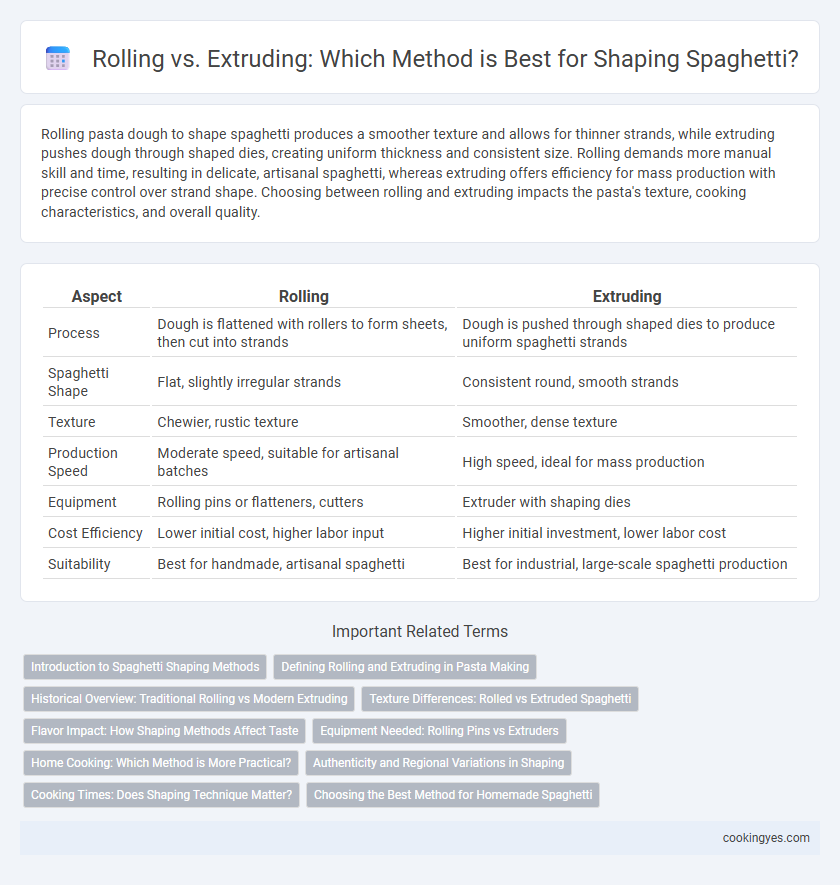Rolling pasta dough to shape spaghetti produces a smoother texture and allows for thinner strands, while extruding pushes dough through shaped dies, creating uniform thickness and consistent size. Rolling demands more manual skill and time, resulting in delicate, artisanal spaghetti, whereas extruding offers efficiency for mass production with precise control over strand shape. Choosing between rolling and extruding impacts the pasta's texture, cooking characteristics, and overall quality.
Table of Comparison
| Aspect | Rolling | Extruding |
|---|---|---|
| Process | Dough is flattened with rollers to form sheets, then cut into strands | Dough is pushed through shaped dies to produce uniform spaghetti strands |
| Spaghetti Shape | Flat, slightly irregular strands | Consistent round, smooth strands |
| Texture | Chewier, rustic texture | Smoother, dense texture |
| Production Speed | Moderate speed, suitable for artisanal batches | High speed, ideal for mass production |
| Equipment | Rolling pins or flatteners, cutters | Extruder with shaping dies |
| Cost Efficiency | Lower initial cost, higher labor input | Higher initial investment, lower labor cost |
| Suitability | Best for handmade, artisanal spaghetti | Best for industrial, large-scale spaghetti production |
Introduction to Spaghetti Shaping Methods
Spaghetti shaping methods primarily include rolling and extruding, each impacting texture and cooking properties. Rolling involves flattening and cutting dough sheets into thin strands, producing a smooth surface ideal for traditional recipes. Extruding forces dough through specialized dies, creating consistent thickness and a slightly rough texture that helps sauce adhesion.
Defining Rolling and Extruding in Pasta Making
Rolling in pasta making involves flattening dough into thin sheets using a rolling pin or pasta machine, ideal for creating uniform thickness before cutting into spaghetti strands. Extruding pushes mixed dough through a die with spaghetti-shaped holes, directly forming the strands and enabling consistent size and texture. Rolling produces smooth, tender pasta surfaces, while extruding often results in a slightly rougher texture that holds sauce better.
Historical Overview: Traditional Rolling vs Modern Extruding
Traditional spaghetti shaping involved rolling dough into thin sheets before cutting it into strands, a method rooted in Italian culinary history that emphasized manual craftsmanship and texture control. Modern extruding techniques use machines to push dough through die molds, enabling consistent thickness and large-scale production while preserving the pasta's structure. This shift from rolling to extruding reflects industrial advancements and changing demands in pasta manufacturing.
Texture Differences: Rolled vs Extruded Spaghetti
Rolled spaghetti typically has a smoother, more uniform texture due to the dough being flattened and cut, resulting in a silkier mouthfeel that absorbs sauces evenly. Extruded spaghetti, shaped by pushing dough through dies, features a slightly rougher surface with microscopic ridges that cling better to sauces, enhancing flavor retention. The textural contrast between rolled and extruded spaghetti influences sauce adherence and overall dining experience.
Flavor Impact: How Shaping Methods Affect Taste
Rolling spaghetti dough creates a denser texture that enhances the absorption of sauces, leading to a richer flavor profile. Extruding methods form pasta with microscopic grooves and a more porous surface, which traps sauce better and intensifies taste through improved sauce adherence. The choice between rolling and extruding directly influences the mouthfeel and flavor delivery in each spaghetti bite.
Equipment Needed: Rolling Pins vs Extruders
Rolling pins require minimal equipment for shaping spaghetti, primarily involving manual effort on flat surfaces to create thin pasta sheets before cutting. Extruders demand specialized machinery equipped with die plates to push dough through precise holes, enabling uniform spaghetti strands with consistent thickness and texture. While rolling pins suit small-scale or artisanal pasta making, extruders optimize efficiency and product consistency in commercial spaghetti production.
Home Cooking: Which Method is More Practical?
Rolling dough for spaghetti at home requires a pasta machine and provides a smooth, consistent thickness but demands more manual effort and time. Extruding uses a pasta extruder to shape the dough through specific die openings, offering quicker production and uniform strands that closely mimic commercial spaghetti. For home cooking, extruding proves more practical due to its speed and ease, while rolling suits those who appreciate traditional methods and precise thickness control.
Authenticity and Regional Variations in Shaping
Rolling spaghetti dough produces thinner, more delicate strands typical of Southern Italian cuisine, emphasizing artisanal authenticity and hand-crafted texture. Extruding through bronze dies creates a rougher surface that holds sauces better, a method favored in industrial-scale production and Northern Italy's pasta traditions. Regional variations highlight how rolling preserves traditional, tender qualities, while extruding supports durability and sauce adherence in diverse Italian culinary practices.
Cooking Times: Does Shaping Technique Matter?
Rolling and extruding are two primary techniques for shaping spaghetti, with extruded pasta typically featuring a denser texture due to the high pressure used in the process. Cooking times for extruded spaghetti tend to be slightly longer, averaging around 9 to 11 minutes, compared to rolled spaghetti, which often cooks in about 7 to 9 minutes. The shaping technique impacts water absorption and texture, influencing the ideal cooking duration for achieving the perfect al dente bite.
Choosing the Best Method for Homemade Spaghetti
Rolling dough for spaghetti shaping produces thin, even sheets ideal for cutting fresh pasta, while extruding forces dough through shaped dies to create uniform strands with a consistent texture. Homemade spaghetti benefits from rolling if a tender, delicate bite is desired, whereas extruding suits recipes requiring firmer, al dente noodles. Selecting the best method depends on available equipment, desired noodle firmness, and the traditional texture preferred in homemade Italian dishes.
Rolling vs extruding for spaghetti shaping Infographic

 cookingyes.com
cookingyes.com